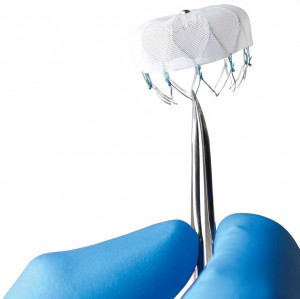A One-Time Procedure That May Reduce Stroke Risk for a Lifetime
The atrial fibrillation and electrophysiology experts at Tampa General Hospital’s Heart and Vascular Institute offer the WATCHMAN™ Left Atrial Appendage Closure (LAAC) Device as an alternative to blood thinners for patients with atrial fibrillation (AFib) not caused by heart valve problems. Implantation of this device is a one-time procedure that lowers stroke risk in patients with AFib by preventing the clots that cause stroke. The WATCHMAN™ device is as effective at reducing stroke as blood thinners, but unlike blood thinner medication, it also reduces the long-term risk of bleeding.
Atrial Fibrillation and Stroke Risk
 Oxygenated blood from the lungs comes into the heart’s left atrium and is pushed out into the left ventricle, where it then travels through the body. In patients with AFib, the heart’s irregular heartbeat interferes with the heart’s ability to properly pump blood throughout the body. Inside the left atrium, those irregular beats can result in blood pooling in a small pouch-like area called the left atrial appendage (LAA). Once the blood pools, it can form clots, which can then break loose, travel to the brain and cause a stroke. In patients with AFib not caused by heart valve problems, more than 90% of stroke-causing clots that originate from the heart are formed in the LAA, making stroke one of the most significant atrial fibrillation risk factors.
Oxygenated blood from the lungs comes into the heart’s left atrium and is pushed out into the left ventricle, where it then travels through the body. In patients with AFib, the heart’s irregular heartbeat interferes with the heart’s ability to properly pump blood throughout the body. Inside the left atrium, those irregular beats can result in blood pooling in a small pouch-like area called the left atrial appendage (LAA). Once the blood pools, it can form clots, which can then break loose, travel to the brain and cause a stroke. In patients with AFib not caused by heart valve problems, more than 90% of stroke-causing clots that originate from the heart are formed in the LAA, making stroke one of the most significant atrial fibrillation risk factors.
The WATCHMAN™ Device is a permanent implant designed to work as a safety net in the heart by closing the left atrial appendage (LAA), effectively stopping blood clots from entering the bloodstream, where they can lead to stroke.
The WATCHMAN™: An Alternative to Blood Thinners
People with AFib often face a lifelong use of blood thinners to reduce their risk of stroke. The WATCHMAN™ implant offers an alternative to the use of warfarin (the most common blood thinner) for people with AFib. The device effectively reduces patients’ risk of stroke without the risk of bleeding that can come with long-term warfarin use.
The WATCHMAN™ Procedure
The WATCHMAN™ Device is a quarter-sized mesh net that covers the left atrial appendage (LAA) in the heart. Doctors implant the WATCHMAN™ through a small cut in the patient’s upper leg and insert a tube, or catheter, inside the vein to guide the WATCHMAN™ Device to the heart’s left atrial appendage (LAA). Once the device is implanted, cells from the inside lining of the heart gradually cover the device, sealing off the appendage so that blood can’t clot inside it.
The one-time procedure takes about an hour. Patients usually stay in the hospital overnight and leave the following day.
The WATCHMAN™ Device is for people who:
-
Have atrial fibrillation not caused by heart valve problems
-
Have been recommended to take blood thinner medication by their doctor
-
Can take warfarin but need an alternative to blood thinners because they have a history of bleeding or a lifestyle that puts them at risk for bleeding
What to Expect
The WATCHMAN™ Device is a quarter-sized mesh net that covers the left atrial appendage (LAA) in the heart. Doctors implant the WATCHMAN™ through a small cut in the patient’s upper leg and insert a tube, or catheter, inside the vein to guide the WATCHMAN™ Device to the heart’s left atrial appendage (LAA). Once the device is implanted, cells from the inside lining of the heart gradually cover the device, sealing off the appendage so that blood can’t clot inside it.
The one-time procedure takes about an hour. Patients usually stay in the hospital overnight and leave the following day.
